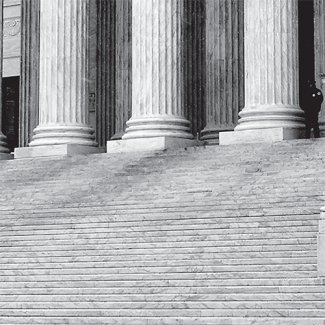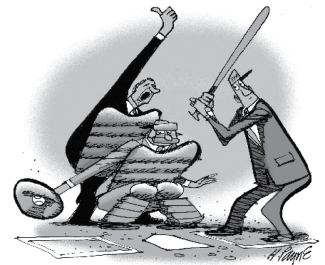The chief justice once said that a judge’s job is limited to calling balls and strikes. Maybe so, but thanks to his Supreme Court, the Environmental Protection Agency now faces a much larger strike zone whenever it steps up to the plate with a new regulation.
On June 28, the Court buried the 40-year-old Chevron doctrine in its decision in Loper Bright Enterprises v. Raimondo, ruling that judges reviewing challenges to a regulation can no longer defer to an agency interpretation of ambiguous statutory language. The day before, in Ohio v. EPA, the Court effectively vacated EPA’s Good Neighbor Rule under the Clean Air Act, which limits cross-boundary pollution contributing to unhealthy ozone levels in downwind states—before the D.C. Circuit had completed its own review. Last year, Sackett v. EPA eliminated EPA’s authority to require permits before landowners fill in wetlands separated from navigable waters by a road, dike, or other physical barrier. And in 2022, West Virginia v. EPA struck down a rule to limit greenhouse gas emissions from power plants—after the Biden administration had cancelled implementation of the rule in question and announced it would soon propose an alternative.
This article raises several critical questions about both the short- and long-term consequences of these recent decisions. More specifically: Does Loper’s guidance about how courts should interpret vague statutory text provide a principled and reasonably consistent basis for judicial review of regulations? Will that case and other recent decisions make it next to impossible for EPA to comply with statutory mandates and deadlines enacted by Congress? The Court’s clampdown on EPA’s regulatory power is a dream come true for the right-wing coalition that swept into Washington with Newt Gingrich 30 years ago. How do anti-regulatory zealots’ oft-repeated claims about bloated bureaucracies and overreach measure up to reality? Last but not least, what can EPA and its supporters do to recover lost ground?
Decided in 1984, Chevron v. NRDC had left plenty of room for skeptical courts to remand or vacate agency decisions that reflected an unconstitutional delegation of legislative authority, conflicted with the law’s plain language or unreasonably interpreted its requirements, was arbitrary or unsupported by evidence, or which violated notice-and-comment requirements or other procedural safeguards. But the 6-3 majority in Loper went further by prohibiting courts from deferring to an agency’s interpretation of ambiguous statutory text. Instead, the judiciary is now duty bound to decide what Congress meant, or must have meant, when agencies make complex, technical decisions based on statutory language that is not clear on its face.
Some have hailed Loper as a long overdue curb on the expansion of the administrative state. Others fear the decision will flood courts with litigation and force judges to make hasty decisions they aren’t qualified to make. For example, where a law requires regulations to limit aircraft noise to “provide for a substantial restoration of the natural quiet,” Justice Kagan’s biting dissent asks, “How much noise is consistent with natural quiet? And how much of the park, for how many hours a day, must be that quiet for the ‘substantial restoration’ requirement to be met?”
What guidance does Loper offer courts trying to reconcile a regulation with an ambiguous statute? First, although a judge may never defer to an agency’s interpretation of its statutory responsibilities, however reasonable, the court can “respect” the agency’s views on its way to determining what Justice Roberts (who wrote for the majority) insists must be the “best” reading of the law. Since courts may decide how much respect to give an agency’s interpretation, this slippery slope risks unpredictable outcomes shaped by the policy preferences of individual judges.
Loper recognizes that federal judges in different circuits may disagree on the “best meaning” of a statutory term, leading to uneven implementation of a federal rule meant to apply nationwide and level the playing field: “We see no reason to presume that Congress prefers uniformity for uniformity’s sake over the correct interpretation of the laws it enacts.”
Deciding upon the best meaning of the law will prove harder than it looks. To get there, Loper directs courts to rely on “traditional principles of statutory construction,” which are unhelpfully not enumerated by Roberts. Indeed, judges do not always agree on what those principles are or how much they matter, so some guidance would have helped.
For example, “textualists” will parse the words of the statute, relying on Black’s Law or other dictionaries for definitions but usually will not consult legislative history to determine their meaning. As a classic textualist, Justice Scalia much preferred Chevron deference to reliance upon legislative history. “Purposivists” will also reach for dictionaries but turn to legislative history if it helps explain what Congress meant when it approved the words in a statute.
Interestingly, although Roberts believes Chevron deference is at odds with the “plain meaning” of the Administrative Procedure Act, he purposively reached outside the statutory text by citing the accompanying House and Senate report language to support his reading. Loper also cites Justice John Marshall’s “foundational decision” in Marbury v. Madison that “it is emphatically the province of and duty of the judicial department to say what the law is.” But Marshall did not hesitate to consult legislative history when exercising that power: “As ‘where the mind labours to discover the design of the legislature, it seizes everything from which aid can be derived.’” Dictionaries can be important aids to interpretation but often show that even common words have multiple and sometimes inconsistent meanings. In such cases, legislative history can sometimes explain what Congress intended by the words in a statute—as Marshall clearly understood. Regardless, after Loper this Court may find it harder to ignore at least the clearest expressions of congressional intent while trying to unearth the “best reading” of statutory requirements.
Ironically, Chevron actually upheld a Reagan administration Clean Air Act rule opposed by the Natural Resources Defense Council. The Supreme Court deferred to EPA’s view that the law applied only to net emission increases from the entire facility, allowing plants to claim that significant increases from modified units would be offset by emission reductions from other units.
Thanks to the complexity, manipulation, and gradual loosening of New Source Review “netting” rules, Chevron deference made it easier to extend the life of the older and dirtier grandfathered power plant units, many of which are still operating today. It has also repeatedly been invoked to dismiss claims that a particular rule is weaker than the law requires. In principle, Loper gives courts more room to consider arguments they previously declined to hear.
But those opportunities may prove limited. The conservatives who dominate today’s Supreme Court were appointed in part to reduce the power of federal agencies. In pursuit of that goal, they have reversed precedent, issued opinions before lower courts have finished review, overturned a regulation suspended by EPA that was due to be replaced anyway, and as Kagan noted in her dissent, decided that Congress could not have meant to authorize the Clean Power Rule—all without much regard for statutory text or traditional rules of construction.
The Court has frequently invoked statements in the Clean Water Act and Clean Air Act regarding the states’ primary role in protecting air and water quality. Yet these broad statements are balanced by others, such as, “It is the national policy that the discharge of toxic pollutants in toxic amounts be prohibited,” and by the many congressional mandates that cannot be preempted by less-stringent state laws.
WILL statutory mandates to regulate go unfulfilled or be interminably delayed as agencies try to anticipate or respond to post-Loper court directives coming in from all circuits? If that effectively keeps EPA from complying with the marching orders it received from Congress, is that not a major transfer of power from both the legislative and executive branches to the judiciary?
Consider the legal and practical constraints the agency already faces when moving a new regulation all the way from proposal through the final stages of judicial review. The 1990 Clean Air Act Amendments, for example, bristle with mandates that order EPA to establish air quality standards to protect health and the environment, review and approve state implementation plans based on a strict set of criteria and replace them with federal implementation plans if those criteria are not met, and establish enforceable emission limits that apply to specific industrial categories. Congress considered these deadlines so important they authorized outside parties to sue the agency for failing to meet them. To emphasize the law’s federal mandates, the word “shall” is used 60 times to describe the state implementation plan requirements of Section 110 of the CAA, 101 times to describe the Title V program requirements that apply to the largest emitters, and 364 times when detailing the standards that apply to sources of hazardous air pollution.
Some of the most important requirements prohibit consideration of their economic cost. Justice Scalia, writing for a unanimous court in Whitman v. American Trucking Associations, held that federal air quality standards must reflect, not cost-effectiveness, but the “maximum airborne concentration that the public health can tolerate,” with an adequate margin of safety to account for uncertainty.
The laws direct EPA to establish pollution control standards and keep them up to date. For example, Section 301(b)(2) of the Clean Water Act charges the agency with establishing effluent limits to curb toxic discharges from specific industries based on “the best available technology economically achievable for such category or class.” EPA must review these at least once every five years and increase their stringency as treatment methods improve because, as the Fifth Circuit explained in 2019 in Southwestern Electric Power v. EPA, “The act . . . mandates a system in which, as available pollution control technology advances, pollution discharges will tighten.” The Clean Air Act includes similar criteria for establishing and reviewing technology-based emission limits.
The CAA and CWA even have “anti-backsliding” provisions to keep pollution limits from eroding over time and preserve hard-won gains in air or water quality. Once a state implementation plan to achieve or maintain air quality standards is approved by EPA, its requirements cannot be relaxed without further review and approval by the federal agency. Even in areas that already meet federal air quality standards, major sources cannot significantly increase emissions by modifying old plants without installing up-to-date pollution controls. With certain exceptions, a state may not reissue, renew, or modify an existing water permit to adopt less-stringent discharge limits or other relaxed permit conditions.
EPA’s regulatory power is substantial but also restrained by the Administrative Procedure Act. The agency cannot adopt or revise a regulation without proposing it first, reviewing and responding to comments that may number in the hundreds of thousands, surviving interagency and Office of Management and Budget review, justifying a final decision based on the rulemaking record—and withstanding judicial review after all that. This step-by-step process is meant to ensure fair and transparent decisionmaking that yields regulations well-grounded in the law and supported by the best evidence.
But over time, both external and internal political forces have added new hazards to EPA’s obstacle course. OMB’s Office of Information and Regulatory Affairs, domiciled in the White House, can hold up review of draft regulations for many months, denying or delaying action when approving the information requests to industry that EPA relies upon to gather supporting evidence. The agency must respond to demands from elected officials weighing in on behalf of favored industries. With some exceptions, EPA must grind through cost-benefit analyses that cannot adequately monetize the health risks associated with major rules.
Caught between its statutory mandates and deadlines, a declining budget, and the relentless anti-regulatory hostility of the Court and today’s Republican Party, it may be easier to build a house in a hundred-mile-an-hour wind than for EPA to complete a rulemaking, no matter how important to public health or the environment. An ongoing coalition of donors, think-tanks, industry lobbyists, and ambitious politicians have worked for decades to cut EPA down to size. Here are a few of their oft-repeated claims (in italics), followed by a reality check.
EPA grew enormously under the Obama and Biden administrations. Wrong. The agency’s full-time workforce averaged 17,421 per year under George W. Bush, 16,028 under Obama, 14,481 under Trump, and 14,664 during Biden’s first three years.
Adjusted for inflation, its $9.2 billion budget in the current fiscal year is about two thirds of what it spent in EPA’s 2001 fiscal year More than half of the total goes out the door as grants to states, cities, research institutions, and nonprofits—or as congressional earmarks. What’s left must cover the agency’s expenses implementing the legislative commands and deadlines of the Clean Air Act, Clean Water Act, Oil Pollution Act, Solid Waste Disposal Act (aka RCRA), Comprehensive Environmental Response, Compensation and Liability Act (Superfund), Safe Drinking Water Act, Emergency Planning and Community Right-to-Know Act, Toxic Substances Control Act, and Federal Insecticide, Fungicide, and Rodenticide Act.
EPA achieved much in its early days, but today’s environmental challenges are less serious and less urgent. The remarkable improvements in air and water quality over the past four to five decades are undeniable. But the U.S. population has grown more than 60 percent over that time period, global warming is leading to hotter and wetter climates that amplify the impact of pollution, and we struggle to react to new challenges while some of our oldest problems stubbornly persist.
Our waterways may be less likely to ignite, but are still plagued by too much bacteria, dangerously low oxygen levels, and a growing epidemic of toxic algae blooms. The 1972 Clean Water Act aimed to achieve “fishable and swimmable waters” no later than 1983. Fifty years later, based on the data that state agencies report to EPA, more than half of the rivers, streams, and lakes that have been assessed are too polluted to support aquatic life or fisheries, to be safe for swimming or other recreational uses, or to provide a reliable source of drinking water. The condition of more than half our river and stream miles has not been evaluated in recent years. The rate of wetlands losses doubled from 2009 to 2019 compared with the previous 10-year period.
After initial progress, the Dallas and Houston metropolitan areas have yet to meet the health-based ozone limits established by George W. Bush’s EPA. Ozone levels have worsened in recent years and the latest data show that Texas also is not meeting fine particle standards the Bush administration established. We are still tallying the damage done by PFAS and other “forever” chemicals, which may trigger the largest and most expensive environmental cleanup in our history.
EPA is throttling the fossil fuel industry. This is a phony crisis. U.S. oil-and-gas production reached their highest levels ever in 2023 and continues to accelerate in 2024. Exxon, Chevron, and Shell reported a combined total of $85.6 billion in profit last year, their second-highest total within the past decade. Since 2021, agencies have issued or revised hundreds of construction permits for new or expanded fertilizer or petrochemical plants, gas processors, compressors, carbon sequestration projects, and liquid natural gas terminals
EPA air quality standards are now unreasonably stringent and do not adequately consider implementation costs. The frequent review and tune-up of air quality standards is a statutory requirement, as Scalia explained in American Trucking. While these health-based standards are not supposed to consider economic burden, EPA estimated it would cost between $1.4 and $2.2 billion to meet the 2015 ozone standard, or between $4 and $7 dollars per capita assuming a full pass-through of costs. Including a margin of safety to ensure that health-based standards for air, water, or drinking water are protective enough is a requirement of law, not EPA “overreach.” The slow motion PFAS disaster that is still unfolding illustrates the high human and economic cost of ignoring the potential for risk until it is too late.
States will take on environmental problems that courts prohibit EPA from addressing. States play a critical role in environmental protection, but the notion that states will take up the slack where federal agencies abandon the field needs closer inquiry. For example, Justice Alito’s opinion in Sackett confidently asserted that “states can and will exercise their primary authority to combat water pollution by regulating land and water use.” In fact, based on an Environmental Integrity Project review completed in May, at least 18 states do not currently require permits before developers dredge or fill any wetlands, while the authority in six more is confined to certain coastal marshes. That list includes 17 of the 25 states that joined an amicus brief asking the Court to shrink EPA’s jurisdiction over wetlands that are adjacent to navigable waters. So far, there is no evidence that these states either “can or will” fill the void.
WHAT can EPA and its partners and constituents do to make up for the loss of Chevron, recognizing that their interests are not always identical? The agency should double-down on its statutory mandates and make a concerted effort to at least come closer to complying with the deadlines for meeting them. The agency is far, far behind in meeting many of these timetables. For example, it has largely ignored the Clean Water Act’s requirement to review the toxic discharge limits for industrial wastewater sources at least once every five years and increase their stringency to reflect any improvements in treatment methods.
The existing standards for 39 of the 50 industrial categories covered by these rules are more than 30 years old, and 22 of them date back to the 1970s or early 1980s. The report to Congress that is supposed to tell us about the state of our nation’s waterways is due every two years. The last version was sent up in 2017. Environmentalists have filed lawsuits to compel EPA’s compliance with these and other deadlines and will continue to do so.
To build an agenda around statutory mandates, the agency should provide a full accounting and ensure the most important are highlighted on the regulatory agenda. While the agency may initially have to give priority to the rulemaking schedules compelled by court order or consent decrees, a more long-term, strategic focus on mandates could ultimately give the agency more control over its work and reduce time-consuming litigation. EPA budgets should clearly identify the resources that will be committed to achieving these statutory requirements, information that is missing from the agency’s spending requests.
EPA cannot realistically promise to meet every single one of its congressional mandates on time. But greater transparency about these commands, when they will be met, and what it would take to do so would give the public a greater appreciation of the scope of the agency’s responsibilities. And clearer communication about these obligations could undercut the chorus of complaints about alleged agency overreach. A back-to-basics approach might also earn the agency some sympathy from justices who at least occasionally refuse to join the majority in striking down EPA rules, including Justice Kavanaugh in Sackett and Justice Coney Barrett in Ohio v. EPA. Even the Heritage Foundation’s Project 25 report recommends that EPA focus on its statutory mandates. We should give Heritage the opportunity to show their support for those mandates.
Following the death of Chevron, all litigants will need to test how the court will apply “traditional principles of statutory construction” to determine the “best meaning” of vague statutory terms. In particular, will the Supreme Court be more willing to consult the legislative history that Scalia set aside in favor of Chevron deference? If John Marshall first originated the idea that we look to courts to say what the law is, can the originalists ignore his at-tempts to understand what legislators had in mind when interpreting the laws they wrote? Also, will the Court at least balance the few words in our environmental statutes that acknowledge the primary role of states against the much lengthier expressions of federal authority that fill page after page of those same laws?
We are where we are today because an extensive conservative network of donors, interest groups, academics, and advocates are determined to reduce the federal government’s power to protect the environment and public health. Instead of directly challenging popular laws like the Clean Air or Clean Water Acts, they have made them much harder to implement, relying on crowd pleasers like “bloated bureaucracy” to shrink EPA’s workforce, and “regulatory overreach” to extend the power of conservative judges to block rules. Give them credit for playing a long game to get a Supreme Court they could only dream of thirty years ago.
Whether EPA will be allowed to retain or recover its authority to implement our environmental laws is as much a political as a legal question, and cannot be answered simply by filing more lawsuits. Environmental groups today are barely visible on Capitol Hill, and I have not seen a commitment to long-term strategy or the kind of deep organizing that moves hearts and minds and shakes up the political class. We will need to find that commitment to keep what we have today and to confront the environmental challenges that are surely coming.





